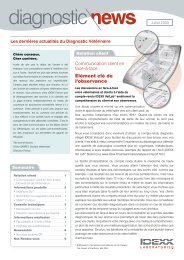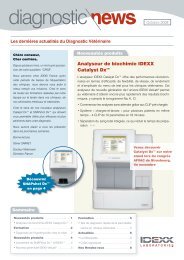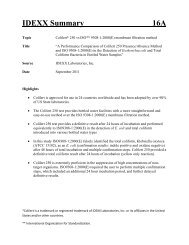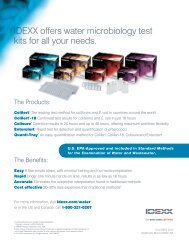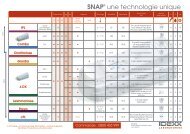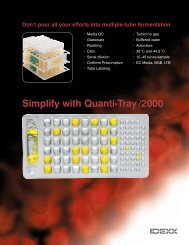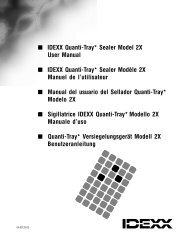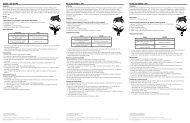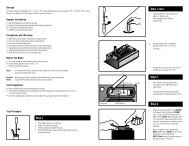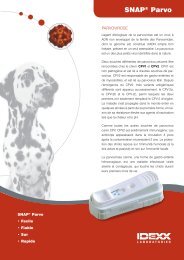Test de détection des Anticorps de la Leishmaniose canine - Idexx
Test de détection des Anticorps de la Leishmaniose canine - Idexx
Test de détection des Anticorps de la Leishmaniose canine - Idexx
You also want an ePaper? Increase the reach of your titles
YUMPU automatically turns print PDFs into web optimized ePapers that Google loves.
Canine Leishmania<br />
Antibody <strong>Test</strong> Kit<br />
For veterinary use only.<br />
<strong>Test</strong> <strong>de</strong> <strong>détection</strong> <strong>de</strong>s <strong>Anticorps</strong><br />
<strong>de</strong> <strong>la</strong> <strong>Leishmaniose</strong> <strong>canine</strong><br />
À l'usage vétérinaire uniquement<br />
Kit di ricerca <strong>de</strong>gli anticorpi <strong>de</strong>l<strong>la</strong><br />
Leishmania <strong>de</strong>l cane<br />
Solo per uso per veterinario.<br />
<strong>Test</strong> para <strong>la</strong> <strong>de</strong>tección <strong>de</strong> Anticuerpos<br />
Anti-Leishmania canina<br />
Para uso veterinario so<strong>la</strong>mente.<br />
SNAP* Leishmania<br />
The Canine Leishmania Antibody <strong>Test</strong> Kit is an Enzyme-linked Immunosorbent assay for in vitro <strong>de</strong>tection<br />
of Leishmania donovani or Leishmania infantum (L. donovani or L. infantum) antibodies in <strong>canine</strong><br />
whole blood, serum, or p<strong>la</strong>sma. Leishmaniasis, caused by parasites of the genus Leishmania, has wi<strong>de</strong><br />
distribution throughout the Mediterranean Basin. The parasites are transmitted by sand flies to many<br />
mammals including humans and <strong>canine</strong>s. Dogs are likely an important reservoir for both the human and<br />
<strong>canine</strong> diseases. Leishmania primarily infect white blood cells leading to impaired immune function, blood<br />
disor<strong>de</strong>rs, and various visceral and/or skin lesions. 1 Clinical signs of visceral leishmaniasis inclu<strong>de</strong> weight<br />
loss, muscle atrophy, <strong>de</strong>rmatitis, and lympha<strong>de</strong>nitis. In dogs, the diagnosis of visceral leishmaniasis can<br />
be ma<strong>de</strong> following observation of typical clinical signs and the measurement of a significant antibody<br />
titer to Leishmania. The Canine Leishmania Antibody <strong>Test</strong> employs purified Leishmania antigen to <strong>de</strong>tect<br />
Leishmania-specific antibody. The SNAP test was optimized with the wi<strong>de</strong>ly used immunofluorescent<br />
assay (IFA) method as the reference standard. A positive result on the SNAP test corre<strong>la</strong>tes to a significant<br />
IFA titer. 2 The SNAP test is an enzyme immunoassay technology <strong>de</strong>veloped by IDEXX Laboratories, Inc.<br />
In operation, the conjugate and test sample are mixed and ad<strong>de</strong>d to the SNAP <strong>de</strong>vice. The <strong>de</strong>vice is then<br />
activated, releasing reagents stored within the <strong>de</strong>vice. Color <strong>de</strong>velopment is proportional to the concentration<br />
of Leishmania-specific (L. donovani or L. infantum) antibodies in <strong>canine</strong> whole blood, serum or<br />
p<strong>la</strong>sma. A Positive Control Spot <strong>de</strong>velops color indicating assay reagents are active. Color <strong>de</strong>velopment in<br />
the Negative Control Spot indicates reactivity unre<strong>la</strong>ted to the disease or an improperly performed test.<br />
Precautions and Warnings<br />
• Use a separate sample tube and transfer pipette for each test.<br />
• During manufacturing the bioactive spots are dyed for quality control purposes. This does not interfere<br />
with the test results or interpretation.<br />
• All waste should be properly <strong>de</strong>contaminated prior to disposal.<br />
• Do not use components past expiration date.<br />
• Do not mix components from kits with different lot numbers.<br />
• The SNAP <strong>de</strong>vice must be in a horizontal position on a f<strong>la</strong>t surface while performing the test.<br />
• Do not use a SNAP <strong>de</strong>vice that has been activated prior to the addition of sample.<br />
Storage<br />
• SNAP <strong>de</strong>vices and test reagents must be stored at 2°C–8°C. All components must be at room<br />
temperature (15°C–25°C) before running the test—DO NOT HEAT.<br />
Kit Components<br />
Item Reagent Amount Amount<br />
1 Leishmania Antigen:HRPO Conjugate 1 x 6.0 mL 2 x 6.0 mL<br />
2 SNAP Device 10 30<br />
Reagents contained in each <strong>de</strong>vice:<br />
Other Components<br />
Wash Solution 0.4 mL 0.4 mL<br />
Substrate Solution 0.6 mL 0.6 mL<br />
transfer pipettes, sample tubes, reagent rack<br />
Sample Information<br />
• Samples must be at room temperature (15°C–25°C) before beginning test procedure.<br />
• Serum or p<strong>la</strong>sma, either fresh, previously frozen or stored at 2°C–8°C, may be used in this test.<br />
• Serum or p<strong>la</strong>sma may be stored for up to 7 days at 2°C–8°C. For longer storage, sample should be<br />
frozen (-20°C or col<strong>de</strong>r).<br />
• Previously frozen or ol<strong>de</strong>r samples must be centrifuged before use.<br />
• Hemolyzed or lypemic samples will not affect results.<br />
• EDTA or heparin in p<strong>la</strong>sma will not affect results.<br />
• Whole blood may be used. Whole blood must be anticoagu<strong>la</strong>ted (eg. EDTA, heparin) and may be used<br />
either fresh or after refrigeration (2°C–8°C) for up to one week.<br />
<strong>Test</strong> Procedure<br />
1. Using the pipette that is provi<strong>de</strong>d, transfer 2 drops of<br />
sample (whole blood, serum, or p<strong>la</strong>sma) into sample<br />
tube.<br />
2. Holding bottle vertical,<br />
add 6 drops of conjugate<br />
to the sample tube.<br />
3. Cap the sample tube and<br />
mix thoroughly by inverting<br />
tube 3–5 times.<br />
4. P<strong>la</strong>ce the <strong>de</strong>vice on a f<strong>la</strong>t surface. 3Add contents of<br />
4<br />
sample tube to Sample Well, being careful not to<br />
sp<strong>la</strong>sh contents outsi<strong>de</strong> of Sample Well. Sample will<br />
flow across Result Window, reaching Activate Circle<br />
in approximately 30–60 seconds. Some sample may<br />
remain in Sample Well.<br />
Watch carefully for sample or blue color in the<br />
Activate Circle.<br />
• When color FIRST appears in Activate Circle push Activator firmly until it is flush with the <strong>de</strong>vice body.<br />
Note: Some samples may not flow to the activate circle within 60 seconds, and, therefore, the circle<br />
may not turn color. In this case, press the Activator after sample has flowed across Result Window.<br />
• Keep the <strong>de</strong>vice horizontal to ensure accurate results.<br />
5. Read test result at 6 minutes.<br />
NOTE: positive control may <strong>de</strong>velop sooner, but results are not complete until 6 minutes.<br />
Interpreting <strong>Test</strong> Result<br />
To <strong>de</strong>termine test results, read the reaction spots in the Result<br />
Window. Color <strong>de</strong>velopment in Leishmania sample spot is proportional<br />
to the Leishmania-specific antibody concentration in the sample.<br />
If no color <strong>de</strong>velops in the positive control spot, repeat the test.<br />
Negative Result<br />
Only positive control spot <strong>de</strong>velops color.<br />
Positive Result<br />
Positive control spot and sample spot <strong>de</strong>velop color.<br />
Reaction with Negative Control<br />
Negative<br />
Control<br />
Positive<br />
Control<br />
Leishmania<br />
Sample<br />
Spot<br />
The negative control spot serves as a safeguard against false positives and helps indicate that the assay<br />
has been run properly.<br />
Positive Result<br />
If color in the sample spot<br />
is darker than negative<br />
control spot, result is<br />
positive for that spot.<br />
Invalid Results<br />
Invalid Result<br />
1. If color in the negative<br />
control spot is equal to or<br />
darker than sample spot,<br />
the test is invalid for that<br />
sample spot.<br />
1. Background<br />
If the sample is allowed to flow past the Activate Circle, background color may result. Some background<br />
color is normal. However, if colored background obscures test result, repeat the test.<br />
2. No Color Development<br />
If positive control does not <strong>de</strong>velop color, repeat the test.<br />
2<br />
1<br />
3<br />
Correct<br />
6<br />
IDEXX Customer Support<br />
USA/Canada 1-800-248-2483 • Europe 00-800-1234-3399 • Australia 1800 655 978<br />
i<strong>de</strong>xx.com<br />
1<br />
Incorrect<br />
2<br />
WRONG<br />
Sample Well<br />
Result Window<br />
Activate Circle<br />
Activator<br />
Not fully<br />
<strong>de</strong>pressed<br />
2.<br />
Version Française<br />
SNAP* Leishmania<br />
Le test <strong>de</strong> <strong>la</strong> <strong>détection</strong> <strong>de</strong>s <strong>Anticorps</strong> <strong>de</strong> <strong>la</strong> <strong>Leishmaniose</strong> <strong>canine</strong> est un test à dosage d’immunoadsorption<br />
par enzyme liée <strong>de</strong> <strong>détection</strong> in vitro <strong>de</strong>s anticorps anti–Leishmania donovani ou anti-Leishmania infantum<br />
(L. donovani ou L. infantum) dans le sang total, le p<strong>la</strong>sma, et le sérum. La <strong>Leishmaniose</strong>, d’origine<br />
parasitaire du type Leishmania, est <strong>la</strong>rgement répandue dans tout le bassin méditérranéen. Ce sont les<br />
moustiques qui transmettent les parasites à différents mammifères comme l’homme ou le chien. Les<br />
chiens constituent un important réservoir <strong>de</strong> <strong>la</strong> ma<strong>la</strong>die pour l’espèce humaine et <strong>canine</strong>. Les Leishmania<br />
vont dans un premier temps infecter les globules b<strong>la</strong>ncs, affaiblissant le système immunitaire, et créer<br />
ensuite <strong>de</strong>s lésions sanguines, viscérales et/ou cutanées. 1 Les signes cliniques observés sont une perte<br />
<strong>de</strong> poids, une atrophie muscu<strong>la</strong>ire, une <strong>de</strong>rmatite, et une lymphadénite. Chez le chien, le diagnostic <strong>de</strong> <strong>la</strong><br />
leishmaniose peut être établi grâce à ces signes cliniques typiques et à un taux d’anticorps significatif. Le<br />
test <strong>de</strong> <strong>détection</strong> <strong>de</strong>s <strong>Anticorps</strong> <strong>de</strong> <strong>la</strong> <strong>Leishmaniose</strong> contient <strong>de</strong>s antigènes <strong>de</strong> Leishmania purifiés permettant<br />
<strong>de</strong> détecter les anticorps spécifiques. Le test SNAP a été comparé avec <strong>la</strong> métho<strong>de</strong> <strong>de</strong> référence,<br />
l’Immunofluorescence (IFA). Un résultat positif sur le test SNAP correspond à un titre significatif obtenu<br />
par immunofluorescence. 2 Le test SNAP est un test immuno-enzymatique développé par les Laboratoires<br />
I<strong>de</strong>xx Inc. Le conjugué et l’échantillon canin sont mé<strong>la</strong>ngés, puis déposés sur le dispositif SNAP. Après<br />
activation du test, les réactifs stockés dans le test SNAP seront libérés. La coloration est proportionnelle<br />
à <strong>la</strong> concentration d’anticorps spécifiques anti-Leishmania (L. donovani ou L. infantum) présents dans le<br />
sang total, p<strong>la</strong>sma ou sérum. Le contrôle positif développe une coloration confirmant <strong>la</strong> validité et <strong>la</strong> qualité<br />
du test. Le changement <strong>de</strong> couleur du contrôle négatif indique une réactivité qui n'est pas spécifique à<br />
<strong>la</strong> ma<strong>la</strong>die ou que le test n'a pas été effectué correctement.<br />
Prècautions d'emploi et mises en gar<strong>de</strong><br />
• Utiliser un tube <strong>de</strong> prélèvement et une pipette <strong>de</strong> transfert différents pour chaque test.<br />
• Les spots bioactifs ont été teintés lors du processus <strong>de</strong> fabrication pour permettre le contrôle <strong>de</strong> qualité<br />
sans que ce<strong>la</strong> interfère avec les résultats du test.<br />
• Tous les déchets doivent être adéquatement décontaminés avant d'être mis au rebut.<br />
• Ne pas utiliser les composants après <strong>la</strong> date <strong>de</strong> péremption.<br />
• Ne pas mé<strong>la</strong>nger les composants <strong>de</strong> kits ayant différents numéros <strong>de</strong> lot.<br />
• Le dispositif SNAP doit être en position horizontale sur une surface p<strong>la</strong>ne pour effectuer le test.<br />
• Ne pas utiliser le dispositif SNAP s'il a été activé avant l'ajout du prélèvement.<br />
Conditions <strong>de</strong> conservation<br />
Les dispositifs SNAP et les réactifs <strong>de</strong> test doivent être conservés entre 2°C et 8°C. Tous les composants<br />
doivent être à température ambiante (15°C–25°C) avant d'effectuer le test - NE PAS CHAUFFER.<br />
Composants du Kit<br />
Article Réactif Quantité Quantité<br />
1 Conjugué Anti-Leishmania HRPO 1 x 6,0 ml 2 x 6,0 ml<br />
2 Dispositif SNAP 10 30<br />
Réactifs présents dans chaque dispositif:<br />
Solution <strong>de</strong> <strong>la</strong>vage 0,4 ml 0,4 ml<br />
Solution <strong>de</strong> substrat 0,6 ml 0,6 ml<br />
Autres composants: pipettes <strong>de</strong> transfer, tubes <strong>de</strong> prélèvement, portoir à réactifs<br />
Informations concernant les prélèvements<br />
• Les prélèvements doivent être portés à température ambiante (15°C–25°C) avant d'effectuer <strong>la</strong><br />
procédure <strong>de</strong> test.<br />
• Il est possible d'utiliser du sérum ou du p<strong>la</strong>sma frais, congelé ou conservé entre 2°C–8°C pour ce test.<br />
• Le sérum et le p<strong>la</strong>sma peuvent être conservés pendant 7 jours maximum entre 2°C–8°C. Pour une<br />
durée <strong>de</strong> conservation plus longue, congeler l'échantillon (-20°C ou plus).<br />
• Les prélèvements congelés ou moins récents doivent être centrifugés avant l'emploi.<br />
• Les prélèvements hémolysés ou lipémiques n'affectent pas les résultats.<br />
• La présence d'EDTA ou d'héparine dans le p<strong>la</strong>sma n'affecte pas les résultats.<br />
• Il est possible d'utiliser du sang total. Le sang total doit être anticoagulé (ex. EDTA, héparine) et peut<br />
s'utiliser frais ou après réfrigération à 2°C–8°C pendant une semaine maximum.<br />
Procédure <strong>de</strong> test<br />
1. À l'ai<strong>de</strong> <strong>de</strong> <strong>la</strong> pipette fournie, verser 2 gouttes <strong>de</strong><br />
prélèvement (sang total, sérum, ou p<strong>la</strong>sma) dans le tube <strong>de</strong><br />
prélèvement.<br />
2. Tenir le f<strong>la</strong>con à <strong>la</strong> verticale et<br />
ajouter 6 gouttes <strong>de</strong> conjugué au<br />
tube <strong>de</strong> prélèvement.<br />
3. Reboucher le tube <strong>de</strong> prélèvement<br />
et mé<strong>la</strong>nger soigneusement par<br />
retournements 3 à 5 fois.<br />
4. P<strong>la</strong>cer le dispositif sur une surface p<strong>la</strong>ne. Ajouter <strong>la</strong> totalité<br />
du contenu du tube <strong>de</strong> prélèvement au puits à 3prélèvement<br />
en veil<strong>la</strong>nt à ne pas répandre le contenu hors du puits. Le<br />
prélèvement va s'écouler sur <strong>la</strong> fenêtre <strong>de</strong> lecture (et faire<br />
disparaître les spots colorés) pour aller jusqu'au cercle<br />
d'activation, qu'il atteint en 30–60 secon<strong>de</strong>s environ. Une<br />
partie du prélèvement peut rester dans le puits.<br />
Vérifier attentivement l'apparition du prélèvement ou<br />
d'une coloration bleue dans le cercle d'activation.<br />
• DÈS QUE <strong>la</strong> couleur apparaît dans le cercle d'activation, appuyer fermement sur l'activateur<br />
jusqu'à ce qu'il soit à niveau avec le corps du dispositif.<br />
Remarque: certains prélèvements peuvent ne pas s'écouler vers le cercle d'activation dans les 60<br />
secon<strong>de</strong>s, auquel cas le cercle ne change pas <strong>de</strong> coloration. Si ce<strong>la</strong> se produit, appuyer sur l'activateur<br />
une fois que le prélèvement a traversé <strong>la</strong> fenêtre <strong>de</strong> lecture.<br />
• Maintenir le dispositif à l'horizontale pour assurer <strong>la</strong> précision <strong>de</strong>s résultats.<br />
5. Attendre 6 minutes avant d'interpréter le résultat.<br />
REMARQUE: le contrôle positif peut changer <strong>de</strong> coloration plus tôt, mais les résultats ne sont définitifs<br />
qu'après 6 minutes.<br />
Interprétation du test<br />
Pour interpréter les résultats du test, lire les spots dans <strong>la</strong> fenêtre<br />
<strong>de</strong> lecture. La coloration <strong>de</strong>s spots-indicateurs est proportionnelle<br />
à <strong>la</strong> concentration en anticorps <strong>de</strong> Leishmania <strong>de</strong> prélèvement.<br />
Si aucune coloration n’apparaît dans le contrôle positif, recommencer<br />
le test.<br />
Résultat Negatif<br />
Seule <strong>la</strong> spot <strong>de</strong> contrôle positif change <strong>de</strong> couleur.<br />
Résultat Positif<br />
Le spot <strong>de</strong> contrôle positif et celui du prélèvement<br />
changent <strong>de</strong> coloration.<br />
Réaction avec le contrôle négatif<br />
Contrôle<br />
négatif<br />
Contrôle<br />
positif<br />
Spot-<br />
Leishmania<br />
Le spot <strong>de</strong> contrôle négatif sert à éviter les résultats faussement positifs et permet <strong>de</strong> s'assurer que le test<br />
a été correctement effectué.<br />
Résultat Positif<br />
Si <strong>la</strong> couleur du spot du<br />
prélèvement Leishmania est plus<br />
sombre que celui du contrôle<br />
négatif, le résultat est positif pour<br />
le spot en question.<br />
Résultats non vali<strong>de</strong>s<br />
Résultat non vali<strong>de</strong><br />
1. Si <strong>la</strong> couleur du spot <strong>de</strong> contrôle négatif 2.<br />
est simi<strong>la</strong>ire ou plus sombre que celle<br />
du spot du prélèvement Leishmania, le<br />
test n'est pas vali<strong>de</strong> pour le spot du<br />
prélèvement en question.<br />
1. Fond<br />
Si le prélèvement a dépassé le cercle d'activation, une coloration <strong>de</strong> fond peut apparaître. Ceci est<br />
normal dans une certaine mesure. Néanmoins, si <strong>la</strong> coloration <strong>de</strong> fond empêche <strong>de</strong> lire le test, il faut<br />
refaire le test.<br />
2. Absence <strong>de</strong> couleur<br />
Si aucune couleur n'apparaît dans le contrôle positif, refaire le test.<br />
2<br />
3<br />
Correct<br />
1<br />
6<br />
1<br />
4<br />
Incorrect<br />
2<br />
Puits à prélèvement<br />
Fenêtre <strong>de</strong> lecture<br />
Cercle d'activation<br />
Activateur<br />
Insuffisamment<br />
enfoncé<br />
Versione Italiana<br />
SNAP* Leishmania<br />
Lo SNAP Leishmania è un saggio immunoenzimatico (ELISA) per <strong>la</strong> ricerca <strong>de</strong>gli anticorpi <strong>de</strong>l<strong>la</strong><br />
Leishmania donovani o Leishmania infantum (L. donovani o L. infantum) nel sangue intero, nel siero, o nel<br />
p<strong>la</strong>sma <strong>de</strong>l cane. La leishmaniosi, ma<strong>la</strong>ttia causata da parassiti <strong>de</strong>l genere Leishmania, è ampiamente<br />
distribuita in tutta l’area <strong>de</strong>l bacino mediterraneo. I parassiti vengono trasmessi dal<strong>la</strong> mosca <strong>de</strong>l<strong>la</strong> sabbia<br />
a numerosi mammiferi, uomo e cane compresi. I cani rappresentano molto probabilmente un importante<br />
serbatoio sia per <strong>la</strong> ma<strong>la</strong>ttia <strong>de</strong>ll’uomo che <strong>de</strong>l cane stesso. La leishmania infetta primariamente i globuli<br />
bianchi compromettendo <strong>la</strong> funzione immunitaria, causando alterazioni <strong>de</strong>l sangue e <strong>de</strong>terminando varie<br />
lesioni viscerali e/o cutanee. 1 I sintomi clinici <strong>de</strong>l<strong>la</strong> leishmaniosi comprendono perdita di peso, atrofia<br />
musco<strong>la</strong>re, <strong>de</strong>rmatite, e linfoa<strong>de</strong>nite. Nel cane, <strong>la</strong> diagnosi di leishmaniosi viscerale può essere fatta<br />
attraverso l’osservazione <strong>de</strong>i tipici sintomi clinici e <strong>la</strong> <strong>de</strong>terminazione di un titolo anticorpale significativo<br />
per <strong>la</strong> leishmania. La prova sierologica per gli anticorpi <strong>de</strong>l<strong>la</strong> leishmania <strong>de</strong>l cane richie<strong>de</strong> l’impiego <strong>de</strong>ll'<br />
antigene purificato <strong>de</strong>l<strong>la</strong> leishmania per consentire l’evi<strong>de</strong>nziazione di anticorpi specifici. Il test SNAP è<br />
stato sviluppato in modo ottimale impiegando il metodo ampiamente usato <strong>de</strong>ll' immunofluorescenza<br />
(IFA) come standard di riferimento. Un risultato positivo con il test SNAP Leishmania è sempre corre<strong>la</strong>to<br />
ad un titolo elevato ottenuto con <strong>la</strong> prova di immunofluorescenza. 2 La prova SNAP si basa su una tecnica<br />
immunoenzimatica e<strong>la</strong>borata dal<strong>la</strong> IDEXX Laboratories, Inc. Nel<strong>la</strong> fase operativa il campione ed il coniugato<br />
vengono mesco<strong>la</strong>ti e aggiunti al dispositivo SNAP. Il dispositivo viene in seguito attivato, provocando il<br />
ri<strong>la</strong>scio <strong>de</strong>i reagenti contenuti nel dispositivo stesso. L'intensità <strong>de</strong>l colore che si sviluppa è proporzionale<br />
al<strong>la</strong> concentrazione di anticorpi specifici per <strong>la</strong> leishmania (L. donovani o L. infantum) presenti nel sangue<br />
intero, nel p<strong>la</strong>sma o nel siero <strong>de</strong>l cane. Una zona di Controllo Positivo indica che i reagenti sono attivi.<br />
L’eventuale sviluppo di colore nel<strong>la</strong> zona di Controllo Negativo evi<strong>de</strong>nzia una reazione aspecifica non corre<strong>la</strong>ta<br />
all’infezione o una non corretta esecuzione <strong>de</strong>l<strong>la</strong> prova.<br />
Precauzioni e avvertenze<br />
• Usare per ciascun test una provetta per campione ed una pipetta di trasferimento diverse.<br />
• Durante <strong>la</strong> produzione le macchie bioattive vengono colorate a fini di controllo <strong>de</strong>l<strong>la</strong> qualità.<br />
Questo non interferisce con l'interpretazione o i risultati <strong>de</strong>lle analisi.<br />
• Tutte le scorie vanno a<strong>de</strong>guatamente <strong>de</strong>contaminate prima <strong>de</strong>ll'eliminazione.<br />
• Non usare alcun componente dopo <strong>la</strong> sua data di sca<strong>de</strong>nza.<br />
• Non mesco<strong>la</strong>re componenti di kit che presentano numeri di lotto diversi.<br />
• Il dispositivo SNAP <strong>de</strong>ve essere in posizione orizzontale su una superficie piana mentre si<br />
esegue l'analisi.<br />
• Non usare un dispositivo SNAP che sia stato attivato prima di inserirvi il campione.<br />
Conservazione<br />
I dispositivi SNAP ed i reagenti per l'analisi vanno conservati a temperature comprese fra 2°C e 8°C. Tutti i componenti<br />
<strong>de</strong>vono essere a temperatura ambiente (15°C–25°C) prima <strong>de</strong>ll'esecuzione <strong>de</strong>ll'analisi–Non riscaldare.<br />
Componenti <strong>de</strong>l kit<br />
Articolo Reagente Quantità Quantità<br />
1 Coniugato Anti-Leishmania: HRPO 1 x 6,0 ml 2 x 6,0 ml<br />
2 Dispositivo SNAP 10 30<br />
Reagenti contenuti in ciascun dispositivo:<br />
Soluzione di <strong>la</strong>vaggio 0,4 ml 0,4 ml<br />
Soluzione di substrato 0,6 ml 0,6 ml<br />
Altri componenti: pipette di trasferiment, provette per campione, rack <strong>de</strong>i reagenti<br />
Informazioni sul campione<br />
• I campioni <strong>de</strong>vono trovarsi a temperatura ambiente (15°C–25°C) prima di iniziare <strong>la</strong> procedura di analisi.<br />
• In questa analisi si possono usare siero o p<strong>la</strong>sma, freschi, prece<strong>de</strong>ntemente conge<strong>la</strong>ti o conservati a<br />
temperature comprese fra 2°C–8°C.<br />
• Il siero o il p<strong>la</strong>sma possono essere conservati a temperature comprese fra 2°C–8°C per un mas simo di 7 giorni.<br />
Per periodi di conservazione più lunghi, il campione va conge<strong>la</strong>to (-20°C o temperature inferiori).<br />
• Campioni prece<strong>de</strong>ntemente conge<strong>la</strong>ti o più vecchi vanno centrifugati prima <strong>de</strong>ll'uso.<br />
• Campioni emolizzati o lipemici non pregiudicheranno i risultati.<br />
• Acido etilendiamino tetracetico (EDTA) o eparina nel p<strong>la</strong>sma non pregiudicheranno i risultati.<br />
• Si può usare sangue intero. Il sangue intero <strong>de</strong>ve essere anticoagu<strong>la</strong>to (per es. con EDTA, eparina) e può<br />
essere usato fresco o dopo <strong>la</strong> refrigerazione a 2°C–8°C per un massimo di una settimana.<br />
Procedura <strong>de</strong>l test<br />
1. Usando <strong>la</strong> pipetta fornita, trasferire 2 gocce di campione<br />
(sangue intero, siero o p<strong>la</strong>sma) nel<strong>la</strong> provetta per campione.<br />
2. Tenendo il f<strong>la</strong>cone in posizione verticale,<br />
aggiungere 6 gocce di coniugato al<strong>la</strong><br />
provetta per campione.<br />
3. Incappucciare <strong>la</strong> provetta per campione e<br />
misce<strong>la</strong>re <strong>de</strong>licatamente il campione mediante<br />
capovolgimento <strong>de</strong>l<strong>la</strong> provetta per 3–5 volte.<br />
4. Porre il dispositivo di analisi su una superficie piana.<br />
Inserire il contenuto <strong>de</strong>l<strong>la</strong> provetta per campione nel 3<br />
pozzetto <strong>de</strong>l campione, facendo attenzione a non<br />
schizzarlo al di fuori <strong>de</strong>l pozzetto. Il campione fluirà<br />
attraverso <strong>la</strong> finestra <strong>de</strong>i risultati, raggiungendo il cerchio di<br />
attivazione in circa 30-60 secondi. Una parte <strong>de</strong>l campione<br />
potrebbe restare nel pozzetto <strong>de</strong>l campione.<br />
Osservare attentamente lo sviluppo di colore nel<br />
cerchio di attivazione.<br />
• APPENA il colore appare nel cerchio di attivazione, premere con<br />
fermezza verso il basso l'attivatore fino a quando non resta a filo con il corpo <strong>de</strong>l dispositivo.<br />
NotA: alcuni campioni potrebbero non fluire nel cerchio di attivazione entro 60 secondi, e quindi il<br />
cerchio potrebbe non cambiare colore. In questo caso, premere l'attivatore dopo che il campione è<br />
passato attraverso <strong>la</strong> finestra <strong>de</strong>i risultati.<br />
• Tenere il dispositivo orizzontale per assicurare risultati precisi.<br />
5. Atten<strong>de</strong>re 6 minuti. Leggere il risultato.<br />
NOTA: il controllo positivo potrebbe svilupparsi prima, ma i risultati non sono completi prima che siano<br />
trascorsi 6 minuti.<br />
Interpretazione <strong>de</strong>i risultati <strong>de</strong>ll'analisi<br />
Per <strong>de</strong>terminare i risultati <strong>de</strong>ll'analisi, leggere le macchie di reazione<br />
nel<strong>la</strong> finestra <strong>de</strong>i risultati. La coloration <strong>de</strong>s spots-indicateurs est<br />
proportionnelle à <strong>la</strong> concentration en anticorps <strong>de</strong> Leishmania <strong>de</strong><br />
l’échantillon.Se nel<strong>la</strong> macchia <strong>de</strong>l controllo positivo non si sviluppa<br />
colore, ripetere l'analisi.<br />
Risultato negativo<br />
Solo <strong>la</strong> macchia <strong>de</strong>l controllo positivo sviluppa colore.<br />
Risultato positivo<br />
La macchia <strong>de</strong>l controllo positivo e quel<strong>la</strong> <strong>de</strong>l<br />
campione Leishmania sviluppano colore.<br />
Reazione con controllo negativo<br />
Controllo<br />
negativo<br />
Controllo<br />
positivo<br />
Indicatore<br />
Leishmania<br />
La macchia <strong>de</strong>l controllo negativo serve a proteggere contro falsi positivi e contribuisce ad indicare che il<br />
dosaggio è stato eseguito in modo corretto.<br />
Risultato positivo<br />
Se il colore nel<strong>la</strong> macchia Leishmania è<br />
più scuro di quello nel<strong>la</strong> macchia <strong>de</strong>l<br />
controllo negativo, il risultato è positivo<br />
Risultati non validi<br />
Risultato non valido<br />
1. Se il colore nel<strong>la</strong> macchia <strong>de</strong>l controllo<br />
negativo è uguale o più scuro rispetto a<br />
quello nel<strong>la</strong> macchia <strong>de</strong>l campione<br />
Leishmania, l'analisi non è valida.<br />
1. Sfondo<br />
Se il campione viene <strong>la</strong>sciato scorrere oltre il cerchio di attivazione, potrebbe generare un colore<br />
di sfondo. Un leggero colore di sfondo è normale. Tuttavia, se lo sfondo colorato oscura il risultato<br />
<strong>de</strong>ll'analisi, ripetere l'analisi.<br />
2. Nessuno sviluppo di colore<br />
GIUSTO<br />
Se il controllo positivo non sviluppa colore, ripetere l'analisi.<br />
1<br />
2<br />
3<br />
6<br />
2<br />
4<br />
1<br />
SBAGLIATO<br />
2<br />
Pozzetto <strong>de</strong>l campione<br />
Finestra <strong>de</strong>i risultati<br />
Cerchio di attivazione<br />
Attivatore<br />
Non completamente<br />
premuto<br />
2.<br />
Versión Españo<strong>la</strong><br />
SNAP* Leishmania<br />
El Snap Leishmania es un análisis inmunoenzimático (ELISA) para <strong>la</strong> <strong>de</strong>tección <strong>de</strong> Anticuerpos Anti-<br />
Leishmania (L. donovani e L. infantum), en p<strong>la</strong>sma, suero o sangre entera <strong>de</strong> perros. La Leishmaniosis,<br />
causada por un parásito <strong>de</strong>l Género Leishmania, se distribuye por toda el area Mediterranea. El parásito<br />
se transmite, a través <strong>de</strong> <strong>la</strong> picadura <strong>de</strong> un mosquito <strong>de</strong>l Género Phlebotomus, a varias especies <strong>de</strong><br />
mamíferos, incluidos el perro y el hombre. Los perros constituyen un importante reservorio <strong>de</strong> <strong>la</strong> enfermedad.<br />
La Leishmania infesta <strong>la</strong>s célu<strong>la</strong>s <strong>de</strong> serie b<strong>la</strong>nca y provoca alteraciones y lesiones cutaneas o/y<br />
viscerales. 1 Los signos clínicos <strong>de</strong> <strong>la</strong> Leishmaniosis incluyen: pérdida <strong>de</strong> peso, atrofia muscu<strong>la</strong>r, <strong>de</strong>rmatitis<br />
y a<strong>de</strong>nopatia. En el perro, el diagnóstico <strong>de</strong> <strong>la</strong> Leishmaniosis se lleva a cabo mediante <strong>la</strong> <strong>de</strong>tección<br />
<strong>de</strong> los síntomas clínicos típicos y <strong>la</strong> <strong>de</strong>tección <strong>de</strong> Anticuerpos Anti-Leishmania, a<strong>de</strong>más, en ocasiones,<br />
<strong>de</strong> <strong>la</strong> observación directa <strong>de</strong>l parásito, en ganglio o médu<strong>la</strong> ósea. El SNAP Leishmania utiliza Antígeno<br />
<strong>de</strong> Leishmania purificado para <strong>de</strong>tectar Anticuerpos específicos Anti-Leishmania. El SNAP Leishmania<br />
ha sido <strong>de</strong>sarrol<strong>la</strong>do utilizando como método <strong>de</strong> referencia (comparativo <strong>de</strong> estudio) <strong>la</strong> Inmuno<br />
Fluorescencia Indirecta (IFI). Un resultado Positivo con SNAP Leishmania corre<strong>la</strong>ciona con un título IFI. 2<br />
SNAP es una tecnologia ELISA (Enzime Linket Inmuno Assay) <strong>de</strong>sarrol<strong>la</strong>da por IDEXX Laboratories, Inc.<br />
Durante el testaje, el conjugado y <strong>la</strong> muestra son mezc<strong>la</strong>dos y añadidos al dispositivo SNAP. Luego, el<br />
SNAP es activado, activandose los reactivos en él incluidos. El <strong>de</strong>sarrollo <strong>de</strong> color es proporcional a <strong>la</strong><br />
concentración <strong>de</strong> Anticuerpos específicos Anti-Leishmania, en p<strong>la</strong>sma, suero o sangre entera <strong>de</strong> perro. El<br />
<strong>de</strong>sarrollo <strong>de</strong> color en el punto <strong>de</strong> Control Positivo nos indica que los reactivos son activos. El <strong>de</strong>sarrollo<br />
<strong>de</strong> color en el punto <strong>de</strong> Control Negativo, indica alguna reacción cruzada o inespecífica o bien un mal<br />
protocolo en el procedimiento <strong>de</strong> realización <strong>de</strong>l test por parte <strong>de</strong>l usuario.<br />
Precauciones y advertencias<br />
• Use un tubo para muestras y una pipeta <strong>de</strong> transferencia diferentes para cada análisis.<br />
• Los puntos bioactivos se tiñen durante <strong>la</strong> e<strong>la</strong>boración, para fines <strong>de</strong> control <strong>de</strong> calidad. Esto no<br />
interfiere con <strong>la</strong> interpretación o los resultados <strong>de</strong>l análisis.<br />
• Todos los <strong>de</strong>sechos <strong>de</strong>ben <strong>de</strong>scontaminarse correctamente antes <strong>de</strong> eliminarse.<br />
• No use los componentes <strong>de</strong>pués <strong>de</strong> su fecha <strong>de</strong> caducidad.<br />
• No mezcle componentes <strong>de</strong> lotes diferentes.<br />
• Durante <strong>la</strong> realización <strong>de</strong>l análisis, el dispositivo SNAP <strong>de</strong>be encontrarse en una posición horizontal<br />
sobre una superficie p<strong>la</strong>na.<br />
• No use un dispositivo SNAP que haya sido activado antes <strong>de</strong> <strong>la</strong> adición <strong>de</strong> <strong>la</strong> muestra.<br />
Almacenamiento<br />
Los dispositivos SNAP y los reactivos <strong>de</strong> prueba <strong>de</strong>berán almacenarse a temperaturas <strong>de</strong> 2°C a 8°C.<br />
Todos los componentes <strong>de</strong>berán estar a temperatura ambiente (15°C–25°C) antes <strong>de</strong> proce<strong>de</strong>r con <strong>la</strong><br />
prueba - NO CALENTAR.<br />
Componentes <strong>de</strong>l kit<br />
Artículo Reactivo Cantidad Cantidad<br />
1 Anti-Leishmania: conjugado <strong>de</strong> HRPO 1 x 6,0 ml 2 x 6,0 ml<br />
2 Dispositivo SNAP 10 30<br />
Reactivos contenidos en cada dispositivo:<br />
Solución <strong>de</strong> <strong>la</strong>vado 0,4 ml 0,4 ml<br />
Solución substrato 0,6 ml 0,6 ml<br />
Otros componentes: pipetas <strong>de</strong> transferencia, tubos <strong>de</strong> muestra, rejil<strong>la</strong> <strong>de</strong> reactivos<br />
Información sobre <strong>la</strong> muestra<br />
• Las muestras <strong>de</strong>berán estar a temperatura ambiente (15°C–25°C) antes <strong>de</strong> iniciarse el procedimiento <strong>de</strong> prueba.<br />
• En esta prueba se pue<strong>de</strong> utilizar suero o p<strong>la</strong>sma, ya sea fresco o que haya estado conge<strong>la</strong>do o<br />
almacenado a 2°C–8°C.<br />
• El suero o p<strong>la</strong>sma pue<strong>de</strong> almacenarse hasta por 7 días a 2°C–8°C. Para un almacenamiento por más tiempo, <strong>la</strong><br />
muestra <strong>de</strong>be conge<strong>la</strong>rse (-20°C o menor temperatura).<br />
• Las muestras previamente conge<strong>la</strong>das o más antiguas <strong>de</strong>ben centrifugarse antes <strong>de</strong> ser utilizadas.<br />
• Las muestras hemolizadas o lipémicas no afectarán los resultados.<br />
• EDTA o heparina en el p<strong>la</strong>sma no afectará los resultados.<br />
• Pue<strong>de</strong> utilizarse sangre total. Con muestras <strong>de</strong> sangre total <strong>de</strong>be <strong>de</strong> utilizarse un anticoagu<strong>la</strong>nte (por<br />
ejemplo, EDTA, heparina) y pue<strong>de</strong> ser usada ya sea fresca o <strong>de</strong>spués <strong>de</strong> ser refrigerada a 2°C–8°C<br />
hasta una semana.<br />
Procedimiento <strong>de</strong> prueba<br />
1. Usando <strong>la</strong> pipeta proporcionada, transfiera 2 gotas <strong>de</strong><br />
muestra (sangre entera, suero o p<strong>la</strong>sma) a un tubo <strong>de</strong><br />
muestra.<br />
2. Manteniendo el frasco en posición vertical,<br />
añada 6 gotas <strong>de</strong> conjugado al tubo <strong>de</strong><br />
muestra.<br />
3. Tape el tubo <strong>de</strong> muestra y mezcle bien<br />
invirtiendo el tubo <strong>de</strong> 3 a 5 veces.<br />
4. Coloque el dispositivo sobre una superficie p<strong>la</strong>na. Añada el<br />
contenido <strong>de</strong>l tubo <strong>de</strong> muestra a <strong>la</strong> cubeta <strong>de</strong> muestra, tenga<br />
cuidado <strong>de</strong> no salpicar el contenido fuera <strong>de</strong> <strong>la</strong> cubeta. La<br />
muestra fluirá a través <strong>de</strong> <strong>la</strong> ventanil<strong>la</strong> <strong>de</strong> resultados llegando al<br />
círculo <strong>de</strong> activación en 30 a 60 segundos aproximadamente.<br />
Parte <strong>de</strong> <strong>la</strong> muestra pue<strong>de</strong> quedar en <strong>la</strong> cubeta <strong>de</strong> muestra.<br />
Observe cuidadosamente para <strong>de</strong>tectar muestra o un color<br />
azul en el círculo <strong>de</strong> activación.<br />
• Cuando COMIENCE a aparecer color en el círculo <strong>de</strong> activación pulse firmemente el activador<br />
hasta que esté a nivel con el cuerpo <strong>de</strong>l dispositivo.<br />
NotA: algunas muestras pue<strong>de</strong>n no fluir al círculo <strong>de</strong> activación <strong>de</strong>ntro <strong>de</strong> los 60 segundos y,<br />
por consiguiente, el círculo pue<strong>de</strong> no colorearse. En este caso, pulse el activador <strong>de</strong>spués que <strong>la</strong><br />
muestra haya pasado a través <strong>de</strong> <strong>la</strong> ventanil<strong>la</strong> <strong>de</strong> resultados.<br />
• Mantenga el dispositivo en posición horizontal para asegurar resultados precisos.<br />
5. Lea el resultado <strong>de</strong> <strong>la</strong> prueba a los 6 minutos.<br />
NOTA: el control positivo pue<strong>de</strong> <strong>de</strong>sarrol<strong>la</strong>rse más pronto, pero los resultados no se completan hasta<br />
los 6 minutos. No <strong>de</strong>primido completamente<br />
Interpretación <strong>de</strong>l resultado <strong>de</strong> <strong>la</strong> prueba<br />
Para <strong>de</strong>terminar los resultados <strong>de</strong> <strong>la</strong> prueba, lea <strong>la</strong>s manchas <strong>de</strong><br />
reacción en <strong>la</strong> ventanil<strong>la</strong> <strong>de</strong> resultados. El <strong>de</strong>sarrollo <strong>de</strong> color en<br />
el punto <strong>de</strong> muestra (indicador <strong>de</strong> leishmania) es proporcional a<br />
<strong>la</strong> concentración <strong>de</strong> anti-cuerpos específicos en <strong>la</strong> muestra. Si <strong>la</strong><br />
mancha <strong>de</strong> control positivo no se colorea, repita <strong>la</strong> prueba.<br />
Resultado negativo<br />
So<strong>la</strong>mente se colorea el punto <strong>de</strong>l control positivo.<br />
Resultado positivo<br />
Se colorean <strong>la</strong> mancha <strong>de</strong> control positivo<br />
y punto <strong>de</strong> muestra.<br />
Reacción con control negativo<br />
Control<br />
negativo<br />
Control<br />
positivo<br />
Indicador <strong>de</strong><br />
Leishmania<br />
La mancha <strong>de</strong> control negativo sirve como una garantía contra positivos falsos y ayuda a indicar que <strong>la</strong><br />
prueba se ha realizado en forma apropiada.<br />
Resultado positivo<br />
Si el color en <strong>la</strong> mancha <strong>de</strong> muestra es<br />
más oscuro que el <strong>de</strong> <strong>la</strong> mancha <strong>de</strong><br />
control negativo, el resultado es positivo<br />
para esa mancha.<br />
Resultado inválido<br />
1. Si el color en <strong>la</strong> mancha <strong>de</strong> control<br />
negativo es igual o más oscuro que el <strong>de</strong><br />
<strong>la</strong> mancha <strong>de</strong> muestra, <strong>la</strong> prueba no es<br />
válida para esa mancha <strong>de</strong> muestra.<br />
Resultados inválidos<br />
1. Fondo<br />
Si se permite que <strong>la</strong> muestra fluya pasando por el círculo <strong>de</strong> activación, el fondo pue<strong>de</strong> colorearse.<br />
Cierto color <strong>de</strong> fondo es normal. Sin embargo si el fondo coloreado oscurece el resultado, <strong>la</strong> prueba<br />
<strong>de</strong>be repetirse.<br />
2. No se <strong>de</strong>sarrol<strong>la</strong> color<br />
Si el control positivo no <strong>de</strong>sarrol<strong>la</strong> color, repita <strong>la</strong> prueba.<br />
2<br />
3<br />
CORRECTO<br />
6<br />
4<br />
1<br />
INCORRECTO<br />
2<br />
Cubeta <strong>de</strong> muestra<br />
Ventanil<strong>la</strong> <strong>de</strong><br />
resultados<br />
Círculo <strong>de</strong> activación<br />
Activador<br />
No <strong>de</strong>primido<br />
completamente<br />
2.<br />
1. Georgi, JR, Georgi, ME. Canine Clinical Parasitology. Phi<strong>la</strong><strong>de</strong>lphia, Lea and Febiger, 1992.<br />
2. The Snap* test gave the same result as the IFA in 98% of the samples tested. IFA <strong>de</strong>veloped by Dr. Tesouro (Univ of Leon),<br />
study performed at Univ of Madrid, 108 IFA Positive Samples, 124 IFA Negative Samples.<br />
Assistance technique IDEXX<br />
USA/Canada 1-800-248-2483 • Europe 00-800-1234-3399 • Australie 1800 655 978<br />
i<strong>de</strong>xx.com<br />
Assistenza tecnica IDEXX<br />
USA/Canada 1-800-248-2483 • Europa 00-800-1234-3399 • Australia 1800 655 978<br />
i<strong>de</strong>xx.com<br />
Asistencia técnica <strong>de</strong> IDEXX<br />
EE.UU./Canada 1-800-248-2483 • Europa 00-800-1234-3399 • Australia 1800 655 978<br />
i<strong>de</strong>xx.com<br />
1. Georgi, JR, Georgi, ME. Canine Clinical Parasitology. Phi<strong>la</strong><strong>de</strong>lphia, Lea and Febiger, 1992.<br />
2. Le test SNAP a été comparé avec <strong>la</strong> métho<strong>de</strong> <strong>de</strong> référence, l'Immunofluorescence (IFA). Les résultats obtenus ont montré un<br />
taux <strong>de</strong> corré<strong>la</strong>tion <strong>de</strong> 98% avec cette même métho<strong>de</strong> sur l'ensemble <strong>de</strong>s échantillons testés. Métho<strong>de</strong> immunofluorescence<br />
développée par Dr Tesouro (université <strong>de</strong> Leon), étu<strong>de</strong> réalisée à l'université <strong>de</strong> Madrid, 108 échantillons positifs en IFA, 124<br />
échantillons négatifs en IFA.<br />
1. Georgi, JR, Georgi, ME. Canine Clinical Parasitology. Phi<strong>la</strong><strong>de</strong>lphia, Lea and Febiger, 1992.<br />
2. Il test SNAP ha dato lo stesso risultato <strong>de</strong>l test di immunofluorescenza (IFA) nel 98% <strong>de</strong>i campioni esaminati. <strong>Test</strong> messo a punto<br />
dal Dr. Tesouro (Università di Leon), studio eseguito all'Università di Madrid, 108 campioni IFA positivi, 124 campioni IFA negativi.<br />
1. Georgi, JR, Georgi, ME. Canine Clinical Parasitology. Phi<strong>la</strong><strong>de</strong>lphia, Lea and Febiger, 1992.<br />
2. El SNAP Leishmania ofrece el mismo resultado que <strong>la</strong> IFI en el 98% <strong>de</strong> <strong>la</strong>s muestras analizadas. Se han procesado 108<br />
muestras Positivas y 124 muestras Negativas en un estudio comparativo entre SNAP Leishmania y <strong>la</strong> IFI <strong>de</strong>sarrol<strong>la</strong>da por el Dr.<br />
M.A. Tesouro en <strong>la</strong> Facut<strong>la</strong> <strong>de</strong> Veterinaria <strong>de</strong> Madrid.<br />
No <strong>de</strong> registro: 0715-RD<br />
*SNAP is a tra<strong>de</strong>marks or registered tra<strong>de</strong>mark of IDEXX Laboratories, Inc. or its affiliates<br />
in the United States and/or other countries.<br />
Covered by U.S. Patent Nos. 5,726,010; 5,726,013; 5,750,333; and/or 6,007,999.<br />
Other U.S. and/or foreign patents issued or pending.<br />
© 2010 IDEXX Laboratories, Inc. All rights reserved. • 06-03749-05<br />
One IDEXX Drive<br />
Westbrook, Maine 04092 USA<br />
i<strong>de</strong>xx.com<br />
*SNAP est une marque <strong>de</strong> commerce ou une marque déposée d’IDEXX Laboratories, Inc.<br />
ou ses filiales aux États-Unis et/ou dans d’autres pays.<br />
Protégé par les brevets américains n° 5,726,010; 5,726,013; 5,750,333; et/ou 6,007,999.<br />
Autres brevets américains et/ou étrangers enregistrés ou en instance.<br />
© 2010 IDEXX Laboratories, Inc. Tous droits réservés.<br />
IDEXX Europe B.V.<br />
P.O. Box 1334<br />
NL–2130 EK Hoofddorp<br />
i<strong>de</strong>xx.com<br />
*SNAP è un marchi di proprietà di, e/o registrati da, IDEXX Laboratories, Inc. o di suoi associate e<br />
protetti negli Stati Uniti e/o in altri Paesi.<br />
Protetto dai brevetti <strong>de</strong>gli U.S.A nn. 5,726,010; 5,726,013; 5,750,333; e/o 6,007,999. Altri brevetti <strong>de</strong>gli<br />
U.S.A e/o stranieri concessi o doman<strong>de</strong> di brevetto <strong>de</strong>gli U.S.A e/o stranieri pen<strong>de</strong>nti.<br />
© 2010 IDEXX Laboratories, Inc. Tutti i diritti sono riservati.<br />
IDEXX Europe B.V.<br />
P.O. Box 1334<br />
NL–2130 EK Hoofddorp<br />
i<strong>de</strong>xx.com<br />
*SNAP es una marca o marca registrada <strong>de</strong> IDEXX Laboratories, Inc. o sus filiares en los Estados<br />
Unidos <strong>de</strong> América y/o en otros países.<br />
Protegida por <strong>la</strong>s patentes norteamericanas número 5,726,010; 5,726,013; 5,750,333; y/o 6,007,999.<br />
Otras patentes norteamericanas y/o extrajeras concedidas o pendientes <strong>de</strong> concesión.<br />
© 2010 IDEXX Laboratories, Inc. Todos los <strong>de</strong>rechos reservados.<br />
IDEXX Europe B.V.<br />
P.O. Box 1334<br />
NL–2130 EK Hoofddorp<br />
i<strong>de</strong>xx.com
Gebrauchsinformation. Die <strong>de</strong>utsche Fassung <strong>de</strong>r Gebrauchsinformation ist entsprechend §17c TierSG zuge<strong>la</strong>ssen.<br />
In vitro-Diagnostikum.<br />
Deutsche Version<br />
SNAP* Leishmania<br />
Das <strong>Test</strong>kit zum Nachweis von Leishmania-Antikörpern beim Hund ist ein ELISA-<strong>Test</strong> (Enzyme-linked<br />
Immunosorbent Assay) zum in vitro-Nachweis von Leishmania donovani- o<strong>de</strong>r Leishmania infantum (L.<br />
donovani o<strong>de</strong>r L. infantum)-Antikörpern in Vollblut, Serum, o<strong>de</strong>r P<strong>la</strong>sma von Hun<strong>de</strong>n. Die durch Parasiten<br />
<strong>de</strong>r Gattung Leishmania verursachte <strong>Leishmaniose</strong> ist im gesamten Mittelmeerraum weit verbreitet.<br />
Die Parasiten wer<strong>de</strong>n durch Sandmücken auf viele Säugetiere, darunter auch Menschen und Hun<strong>de</strong>,<br />
übertragen. Hun<strong>de</strong> sind naheliegend ein wichtiger Reservoirwirt für die Krankheit beim Menschen<br />
und Hund. <strong>Leishmaniose</strong>-Erreger infizieren vorwiegend die weißen Blutzellen, was zu Vermin<strong>de</strong>rung<br />
<strong>de</strong>r Immunfunktion, Bluterkrankungen und verschie<strong>de</strong>nen viszeralen und/o<strong>de</strong>r Hautläsionen führt. 1<br />
Die klinischen Anzeichen <strong>de</strong>r viszeralen <strong>Leishmaniose</strong> umfassen Gewichtsabnahme, Muske<strong>la</strong>trophie,<br />
Dermatitis und Lympha<strong>de</strong>nitis. Bei Hun<strong>de</strong>n kann die Diagnose <strong>de</strong>r viszeralen <strong>Leishmaniose</strong> anhand<br />
<strong>de</strong>r Beobachtung <strong>de</strong>r typischen klinischen Anzeichen und Messung eines signifikanten Antikörpertiters<br />
gegen Leishmania erfolgen. Der Leishmania-Antikörpertest für Hun<strong>de</strong> verwen<strong>de</strong>t gereinigtes Leishmania-<br />
Antigen zum Nachweis von Leishmania-spezifischen Antikörpern. Der SNAP <strong>Test</strong> wur<strong>de</strong> mittels <strong>de</strong>r<br />
häufig verwen<strong>de</strong>ten IFA-Metho<strong>de</strong> (Immunfluoreszenz-Assay) als Referenzstandard optimiert. Ein positives<br />
Ergebnis <strong>de</strong>s SNAP <strong>Test</strong>s korreliert mit einem signifikanten IFA-Titer. 2 Der von IDEXX Laboratories,<br />
Inc. entwickelte SNAP <strong>Test</strong> ist eine Enzym-Immunassay-Technologie. Beim Einsatz wer<strong>de</strong>n das Konjugat<br />
und die <strong>Test</strong>probe vermischt und in die SNAP <strong>Test</strong>einheit gegeben. Wenn nun die <strong>Test</strong>einheit aktiviert<br />
wird, wer<strong>de</strong>n die darin befindlichen Reagenzien freigesetzt. Die Farbentwicklung ist proportional zur<br />
Konzentration Leishmania-spezifischer (L. donovani o<strong>de</strong>r L. infantum) Antikörper im Vollblut, Serum o<strong>de</strong>r<br />
P<strong>la</strong>sma von Hun<strong>de</strong>n. Eine Färbung an <strong>de</strong>r positiven Kontrol<strong>la</strong>nzeige zeigt an, dass die <strong>Test</strong>reagenzien<br />
aktiv sind. Eine Farbentwicklung an <strong>de</strong>r negativen Kontrol<strong>la</strong>nzeige zeigt eine nicht mit <strong>de</strong>r Erkrankung<br />
verbun<strong>de</strong>ne Reaktivität o<strong>de</strong>r eine falsche <strong>Test</strong>ausführung an. Zur Ermittlung <strong>de</strong>r <strong>Test</strong>ergebnisse wer<strong>de</strong>n<br />
die Reaktionsanzeigen im Auswertefenster abgelesen. Eine Farbentwicklung an <strong>de</strong>r Leishmania-<br />
Probenanzeige ist proportional zur Leishmania-spezifischen Antikörperkonzentration <strong>de</strong>r Probe. Der <strong>Test</strong><br />
ist zu wie<strong>de</strong>rholen, wenn sich an <strong>de</strong>r positiven Kontrol<strong>la</strong>nzeige keine Färbung einstellt.<br />
Vorsichtsmaßnahmen und Warnhinweise<br />
• Für je<strong>de</strong>n <strong>Test</strong> ein neues Probenröhrchen und eine neue Transferpipette verwen<strong>de</strong>n.<br />
• Bei <strong>de</strong>r Herstellung wer<strong>de</strong>n die bioaktiven Punkte aus Grün<strong>de</strong>n <strong>de</strong>r Qualitätskontrolle gefärbt. Die<br />
<strong>Test</strong>ergebnisse o<strong>de</strong>r -auswertung wer<strong>de</strong>n hierdurch nicht beeinträchtigt.<br />
• Alle Abfälle sind vor <strong>de</strong>r Entsorgung vorschriftsmäßig zu <strong>de</strong>kontaminieren.<br />
• <strong>Test</strong>bestandteile nicht über das Verfallsdatum hinaus verwen<strong>de</strong>n.<br />
• Bestandteile aus Kits mit unterschiedlichen Chargennummern nicht zusammen verwen<strong>de</strong>n.<br />
• Die SNAP-<strong>Test</strong>einheit muss für die Dauer <strong>de</strong>r <strong>Test</strong>durchführung waagerecht auf einer ebenen<br />
Unter<strong>la</strong>ge stehen.<br />
• Wur<strong>de</strong> die SNAP-<strong>Test</strong>einheit vor Zugabe <strong>de</strong>r Probe aktiviert, sollte sie nicht verwen<strong>de</strong>t wer<strong>de</strong>n.<br />
Lagerung<br />
SNAP-<strong>Test</strong>einheiten und <strong>Test</strong>reagenzien sind bei 2°C–8°C zu <strong>la</strong>gern. Alle Komponenten müssen vor <strong>de</strong>r<br />
Durchführung <strong>de</strong>s <strong>Test</strong>s auf Zimmertemperatur (15°C–25°C) gebracht wer<strong>de</strong>n - NICHT ERHITZEN.<br />
Kitkomponenten<br />
Artikel Reagenz Menge Menge<br />
1 Anti-Leishmania: HRPO-Konjugat 1 x 6,0 ml 2 x 6,0 ml<br />
2 SNAP <strong>Test</strong>einheit 10 30<br />
In je<strong>de</strong>r <strong>Test</strong>vorrichtung enthaltene Reagenzien:<br />
Waschlösung 0,4 ml 0,4 ml<br />
Substratlösung 0,6 ml 0,6 ml<br />
Sonstige Komponenten: Transferpipetten, Probenröhrchen, Reagenzienstän<strong>de</strong>r<br />
Gebrauchsinformation<br />
• Vor <strong>de</strong>r <strong>Test</strong>durchführung müssen die Proben auf Zimmertemperatur (15°C–25°C) gebracht wer<strong>de</strong>n.<br />
• Für diesen <strong>Test</strong> kann frisches, gefrorenes o<strong>de</strong>r bei 2°C–8°C ge<strong>la</strong>gertes Serum o<strong>de</strong>r P<strong>la</strong>sma<br />
verwen<strong>de</strong>t wer<strong>de</strong>n.<br />
• Serum o<strong>de</strong>r P<strong>la</strong>sma kann bis zu 7 Tage bei 2°C–8°C ge<strong>la</strong>gert wer<strong>de</strong>n. Zur längeren Lagerung sollte die<br />
Probe gefroren wer<strong>de</strong>n (-20° C o<strong>de</strong>r kälter).<br />
• Gefrorene o<strong>de</strong>r ältere Proben sind vor <strong>de</strong>r Verwendung zu zentrifugieren.<br />
• Die Ergebnisse wer<strong>de</strong>n durch hämolysierte o<strong>de</strong>r lipämische Proben nicht beeinträchtigt.<br />
• Die Ergebnisse wer<strong>de</strong>n durch EDTA o<strong>de</strong>r Heparin im P<strong>la</strong>sma nicht beeinträchtigt.<br />
• Vollblut ist für <strong>de</strong>n <strong>Test</strong> geeignet. Vollblut ist zu antikoagulieren (z.B. EDTA, Heparin) und ist entwe<strong>de</strong>r frisch<br />
o<strong>de</strong>r nach gekühlter Lagerung über einen Zeitraum von max. 1 Woche bei 2°C–8°C verwendbar.<br />
<strong>Test</strong>verfahren<br />
1. Mit <strong>de</strong>r im Lieferumfang enthaltenen Pipette 2 Tropfen <strong>de</strong>r<br />
Probe (Vollblut, Serum o<strong>de</strong>r P<strong>la</strong>sma) in das Probenröhrchen<br />
pipettieren.<br />
2. Die Konjugatf<strong>la</strong>sche senkrecht halten und<br />
6 Tropfen Konjugat in das Probenröhrchen<br />
hinzufügen.<br />
3. Das Probenröhrchen verschließen und<br />
3–5 mal umdrehen, um <strong>de</strong>n Inhalt gut<br />
zu vermischen.<br />
4. Die <strong>Test</strong>einheit auf eine ebene Unter<strong>la</strong>ge stellen. Den<br />
Inhalt <strong>de</strong>s Probenröhrchens in die Probenvertiefung<br />
geben. Dabei sollte nichts außerhalb <strong>de</strong>r<br />
Probenvertiefung verspritzt wer<strong>de</strong>n. Die Probe fließt<br />
nun über das Ergebnisfenster und erreicht nach ca.<br />
30 bis 60 Sekun<strong>de</strong>n das Aktivierungsauge. Es kann<br />
vorkommen, dass ein Rest <strong>de</strong>r Probe in <strong>de</strong>r<br />
Probenvertiefung zurückbleibt.<br />
Achten Sie sorgfältig auf das Erscheinen von Probenmaterial<br />
o<strong>de</strong>r B<strong>la</strong>ufärbung im Aktivierungsauge.<br />
• SOBALD sich das Aktivierungsauge zu verfärben beginnt, <strong>de</strong>n Aktivator fest herunter drücken,<br />
bis er genau mit <strong>de</strong>m Rand <strong>de</strong>r <strong>Test</strong>einheit abschließt.<br />
Hinweis: Manchmal fließt die Probe nicht innerhalb von 60 Sekun<strong>de</strong>n zum Aktivierungsauge und <strong>de</strong>r<br />
Kreis nimmt eventuell keine Färbung an. In diesem Fall ist <strong>de</strong>r Aktivator zu drücken, wenn die Probe<br />
durch das Ergebnisfenster geflossen ist.<br />
• Um korrekte Ergebnisse zu gewährleisten, ist es notwendig, dass sich die <strong>Test</strong>einheit in horizontaler<br />
Lage befin<strong>de</strong>t.<br />
5. Nach 6 Minuten das Ergebnis ablesen.<br />
HINWEIS: Die positive Kontrolle kann sich schon früher verfärben, jedoch sind die Ergebnisse erst<br />
nach 6 Minuten gültig.<br />
<strong>Test</strong>auswertung<br />
Zur Ermittlung <strong>de</strong>s <strong>Test</strong>ergebnisses die Reaktionsfel<strong>de</strong>r<br />
im Ergebnisfenster ablesen. Die Farbentwicklung an <strong>de</strong>n<br />
Indikatorfel<strong>de</strong>rn ist proportional zur Leishmania-Antikörper-<br />
Konzentration <strong>de</strong>r Probe. Der <strong>Test</strong> ist zu wie<strong>de</strong>rholen, wenn<br />
sich bei <strong>de</strong>r positiven Kontrolle keine Färbung einstellt.<br />
Negatives Ergebnis<br />
Nur die positive Kontrolle verfärbt sich.<br />
Positives Ergebnis<br />
Die positive Kontrolle und das Leishmania-Ak-<br />
Indikatorfeld verfärben sich.<br />
Reaktion mit negativer Kontrolle<br />
Negative<br />
Kontrolle<br />
Eine Verfärbung <strong>de</strong>r negativen Kontrolle ist eine Rückversicherung gegen falsch positive Ergebnisse.<br />
Positives Ergebnis<br />
Wenn die Färbung <strong>de</strong>s Leishmania-Ak-<br />
Indikatorfeld dunkler ist als die negative<br />
Kontrolle, ist das Ergebnis für dieses<br />
Indikatorfeld positiv.<br />
<strong>Test</strong>kit zum Nachweis von Leishmania-Antikörpern<br />
beim Hund<br />
2<br />
3<br />
RICHTIG<br />
Ungültige Ergebnisse<br />
1. Wenn die Färbung <strong>de</strong>r negativen Kontrolle<br />
2.<br />
gleich o<strong>de</strong>r dunkler als die <strong>de</strong>s Leishmania-<br />
Ak-Indikatorfeld ist, ist <strong>de</strong>r <strong>Test</strong> für dieses<br />
Feld ungültig.<br />
Positive<br />
Kontrolle<br />
Leishmania<br />
Antikörper<br />
Indikatorfeld<br />
Ungültiges Ergebnis<br />
1. Hintergrund<br />
Wenn die Probe über das Aktivierungsauge hinaus läuft, kann sich eine Hintergrundfärbung ergeben.<br />
Etwas Hintergrundfarbe ist normal. Wenn jedoch ein farbiger Hintergrund das <strong>Test</strong>ergebnis über<strong>de</strong>ckt,<br />
ist <strong>de</strong>r <strong>Test</strong> zu wie<strong>de</strong>rholen.<br />
2. Keine Farbentwicklung<br />
Wenn sich keine Verfärbung <strong>de</strong>r positiven Kontrolle einstellt, ist <strong>de</strong>r <strong>Test</strong> zu wie<strong>de</strong>rholen. Wenn die Färbung<br />
<strong>de</strong>s Indikatorfel<strong>de</strong>s dunkler ist als die <strong>de</strong>r negativen Kontrolle, ist das Ergebnis positiv.<br />
IDEXX Technischer Kun<strong>de</strong>ndienst<br />
VS/Canada 1-800-248-2483 • Europa 00-800-1234-3399 • Australien 1800-655-978<br />
i<strong>de</strong>xx.com<br />
1. Georgi, JR, Georgi, ME. Canine Clinical Parasitology. Phi<strong>la</strong><strong>de</strong>lphia, Lea and Febiger, 1992.<br />
2. Der SNAP* <strong>Test</strong> erzielte bei 98% <strong>de</strong>r getesteten Proben das gleiche Ergebnis wie <strong>de</strong>r IFA. Der IFA wur<strong>de</strong> von Dr. Tesouro<br />
(Universität Leon) entwickelt. Die Studie wur<strong>de</strong> an <strong>de</strong>r Universität Madrid durchgeführt. 108 positive IFA-Proben, 124 negative<br />
IFA-Proben.<br />
6<br />
1<br />
4<br />
FALSCH<br />
Nur zum tierärztlichen Gebrauch.<br />
2<br />
Probenvertiefung<br />
Ergebnisfenster<br />
Aktivierungsauge<br />
Aktivator<br />
Nicht vollständig<br />
herunter gedrückt<br />
Leishmania antistoffentestkit voor hon<strong>de</strong>n<br />
Uitsluitend voor veterinair gebruik.<br />
De Ne<strong>de</strong>r<strong>la</strong>ndse Versie<br />
SNAP* Leishmania<br />
De Leishmania antistoffentestkit voor hon<strong>de</strong>n is een ELISA (Enzyme-linked Immunosorbent Assay)<br />
analyse voor in-vitro <strong>de</strong>tectie van Leishmania donovani- of Leishmania infantum- (L. donovani of L.<br />
infantum) antistoffen in heel bloed, serum, of p<strong>la</strong>sma van hon<strong>de</strong>n. Leishmaniasis, veroorzaakt door<br />
parasieten van het genus Leishmania, komt wijdverspreid voor in het Mid<strong>de</strong>l<strong>la</strong>ndse-Zeegebied. De<br />
parasieten wor<strong>de</strong>n door zandmuggen overgedragen aan veel zoogdieren, waaron<strong>de</strong>r mensen en<br />
hon<strong>de</strong>n. Hon<strong>de</strong>n zijn waarschijnlijk een be<strong>la</strong>ngrijk reservoir voor zowel <strong>de</strong> menselijke als hon<strong>de</strong>nziekten.<br />
Leishmania infecteren voornamelijk witte bloedlichaampjes, hetgeen leidt tot verstoor<strong>de</strong> immuunfunctie,<br />
bloedaandoeningen en verschillen<strong>de</strong> viscerale en/of huid<strong>la</strong>esies. 1 Klinische tekenen van viscerale<br />
leishmaniasis zijn on<strong>de</strong>r meer gewichtsverlies, spieratrofie, <strong>de</strong>rmatitis en lymfa<strong>de</strong>nitis. Bij hon<strong>de</strong>n kan<br />
<strong>de</strong> diagnose van viscerale leishmaniasis wor<strong>de</strong>n gesteld na het observeren van typische klinische<br />
tekenen en <strong>de</strong> meting van een aanzienlijk antistoftiter tegen Leishmania. De Leishmania antistoftest voor<br />
hon<strong>de</strong>n gebruikt gezuiverd Leishmania-antigen om Leishmania-specifieke antistof te <strong>de</strong>tecteren. De<br />
SNAP-test werd geoptimaliseerd met <strong>de</strong> veel gebruikte immunofluoresceren<strong>de</strong> analyse (IFA)-metho<strong>de</strong><br />
als referentienorm. Een positief resultaat van <strong>de</strong> SNAP-test correleert met een aanzienlijk IFA-titer. 2 De<br />
SNAP-test is een enzym immunoanalysetechnologie die ontwikkeld is door IDEXX Laboratories Inc. In<br />
gebruik wor<strong>de</strong>n het conjugaat en het testmonster gemengd en aan het SNAP-instrument toegevoegd.<br />
Het instrument wordt vervolgens geactiveerd en er komen in het instrument opges<strong>la</strong>gen mid<strong>de</strong>len vrij. De<br />
kleurontwikkeling is in verhouding tot <strong>de</strong> concentratie Leishmania-specifieke (L. donovani of L. infantum)<br />
antistoffen in heel bloed, serum of p<strong>la</strong>sma van hon<strong>de</strong>n. Een positieve controlestip ontwikkelt kleur die<br />
aangeeft dat <strong>de</strong> analysereagentia actief zijn. Kleurontwikkeling in <strong>de</strong> negatieve controlestip duidt op<br />
reactiviteit die niet in verband staat met <strong>de</strong> ziekte of op een onjuist uitgevoer<strong>de</strong> test. Om het testresultaat<br />
vast te stellen dient u <strong>de</strong> reactiestippen in het resultaatvenster af te lezen. Kleurontwikkeling in <strong>de</strong><br />
Leishmania-monsterstip is in verhouding tot <strong>de</strong> concentratie van Leishmania-specifieke antistof in het<br />
monster. Als er zich geen kleur ontwikkelt in <strong>de</strong> positieve controlestip, dient u <strong>de</strong> test te herhalen.<br />
Voorzorgsmaatregelen en waarschuwingen<br />
• Gebruik voor elke test een apart monsterbuisje en transferpipet.<br />
• Tij<strong>de</strong>ns <strong>de</strong> fabricage wor<strong>de</strong>n <strong>de</strong> biologisch actieve stippen gekleurd voor kwaliteitscontrole. Dit heeft<br />
geen invloed op <strong>de</strong> testresultaten of <strong>de</strong> interpretatie ervan.<br />
• Alle afval dient behoorlijk ontsmet te wor<strong>de</strong>n alvorens het wordt afgevoerd.<br />
• De on<strong>de</strong>r<strong>de</strong>len niet na <strong>de</strong> uiterste gebruiksdatum gebruiken.<br />
• Geen on<strong>de</strong>r<strong>de</strong>len van kits met verschillen<strong>de</strong> partijnummers door elkaar gebruiken.<br />
• Het SNAP-instrument moet horizontaal op een v<strong>la</strong>kke on<strong>de</strong>rgrond zijn terwijl <strong>de</strong> test wordt uitgevoerd.<br />
• Geen SNAP-instrument gebruiken dat geactiveerd is voordat een monster werd toegevoegd.<br />
Ops<strong>la</strong>g<br />
SNAP-instrumenten en testreagentia moeten bij 2°C–8°C wor<strong>de</strong>n bewaard. Alle on<strong>de</strong>r<strong>de</strong>len moeten op<br />
kamertemperatuur (15°C–25°C) zijn voordat <strong>de</strong> test wordt uitgevoerd - NIET VERWARMEN.<br />
Kiton<strong>de</strong>r<strong>de</strong>len<br />
Artikel Reagens Hoeveelheid Hoeveelheid<br />
1 Anti-Leishmania: HRPO-conjugaat 1 x 6,0 ml 2 x 6,0 ml<br />
2 SNAP-instrument 10 30<br />
Reagentia in elk instrument:<br />
Spoelvloeistof 0,4 ml 0,4 ml<br />
Substraatvloeistof 0,6 ml 0,6 ml<br />
Overige on<strong>de</strong>r<strong>de</strong>len: transferpipetten, buisjes, reagensrek<br />
Monsterinformatie<br />
• Monsters moeten op kamertemperatuur (15°C–25°C) zijn voordat met <strong>de</strong> testprocedure wordt begonnen.<br />
• Voor <strong>de</strong>ze test kan serum of p<strong>la</strong>sma, hetzij vers, eer<strong>de</strong>r ingevroren of bewaard bij 2°C–8°C, wor<strong>de</strong>n gebruikt.<br />
• Serum of p<strong>la</strong>sma kan maximaal 7 dagen bij 2°C–8°C wor<strong>de</strong>n bewaard. Voor <strong>la</strong>ngere ops<strong>la</strong>g dient het<br />
monster te wor<strong>de</strong>n ingevroren (-20°C of kou<strong>de</strong>r).<br />
• Eer<strong>de</strong>r ingevroren of ou<strong>de</strong>re monsters moeten vóór gebruik wor<strong>de</strong>n gecentrifugeerd.<br />
• Gehemolyseer<strong>de</strong> of lipemische monsters hebben geen invloed op <strong>de</strong> resultaten.<br />
• EDTA of heparine in p<strong>la</strong>sma heeft geen invloed op <strong>de</strong> resultaten.<br />
• Er kan vol bloed wor<strong>de</strong>n gebruikt. Vol bloed moet wor<strong>de</strong>n geanticoaguleerd (bijv. EDTA, heparine) en<br />
kan hetzij vers of na koel bewaren bij 2°C–8°C tot maximaal een week wor<strong>de</strong>n gebruikt.<br />
<strong>Test</strong>procedure<br />
1. Met <strong>de</strong> meegelever<strong>de</strong> pipet, 2 druppels<br />
monster (heel bloed, serum of p<strong>la</strong>sma) in het<br />
buisje druppelen.<br />
2. Terwijl u het flesje verticaal houdt<br />
6 druppels conjugaat aan het buisje<br />
toevoegen.<br />
3. De dop op het monsterbuisje drukken<br />
en <strong>de</strong> inhoud grondig mengen door<br />
het buisje 3–5 keer om te draaien.<br />
4. Het instrument op een v<strong>la</strong>kke on<strong>de</strong>rgrond zetten. De<br />
inhoud van het monsterbuisje in <strong>de</strong> "Holte voor monsters"<br />
gieten, waarbij u ervoor oppast dat u <strong>de</strong> inhoud ervan niet<br />
buiten <strong>de</strong> monsterholte <strong>la</strong>at spatten. Het monster stroomt<br />
door het resultaatvenster en bereikt <strong>de</strong> activeercirkel na<br />
ongeveer 30–60 secon<strong>de</strong>n. Er kan wat monster in <strong>de</strong><br />
monsterholte achterblijven; dit is normaal.<br />
Zorgvuldig kijken of het monster of een b<strong>la</strong>uwe kleur in<br />
<strong>de</strong> activeercirkel verschijnt.<br />
• ZODRA <strong>de</strong> kleur in <strong>de</strong> cirkel verschijnt, <strong>de</strong> Activator stevig indrukken tot <strong>de</strong>ze niet meer boven<br />
het toestelopperv<strong>la</strong>k uitsteekt.<br />
NB: Sommige monsters stromen niet binnen 60 secon<strong>de</strong>n naar <strong>de</strong> activeercirkel en het kan dus zijn<br />
dat er geen kleur in <strong>de</strong> cirkel verschijnt. In dat geval op <strong>de</strong> activator drukken nadat het monster door<br />
het resultaatvenster is gestroomd.<br />
• Het instrument horizontaal hou<strong>de</strong>n om een nauwkeurig resultaat te garan<strong>de</strong>ren<br />
5. De testresultaten na 6 minuten aflezen.<br />
NB: <strong>de</strong> positieve controle kan sneller ontwikkelen, maar <strong>de</strong> resultaten zijn pas na 6 minuten <strong>de</strong>finitief.<br />
Interpreteren van <strong>de</strong> testresultaten<br />
Om het testresultaat vast te stellen <strong>de</strong> reactiestippen in het<br />
resultaatvenster aflezen. Kleurontwikkeling in <strong>de</strong> monsterstip is<br />
in verhouding tot <strong>de</strong> concentratie van Leishmania-antristoffen<br />
in het monster. Als er zich geen kleur ontwikkelt in <strong>de</strong> positieve<br />
controle, dient u <strong>de</strong> test te herhalen.<br />
Negatief resultaat<br />
Er ontwikkelt zich alleen kleur in <strong>de</strong> positieve controle.<br />
Positief resultaat<br />
Er ontwikkelt zich kleur in <strong>de</strong> positieve controlestip<br />
en <strong>de</strong> Leishmania-monsterstip.<br />
Reactie met negatieve controle<br />
Negatieve<br />
controle<br />
Positieve<br />
controle<br />
Leishmaniamonsterstip<br />
De negatieve controlestip dient als beveiliging tegen valse positieven en geeft aan dat <strong>de</strong> analyse op <strong>de</strong><br />
juiste manier is uitgevoerd.<br />
Positief resultaat<br />
Als <strong>de</strong> kleur in <strong>de</strong> Leishmaniamonsterstip<br />
donker<strong>de</strong>r is dan <strong>de</strong> kleur<br />
in <strong>de</strong> negatieve controlestip, is het<br />
resultaat positief voor die stip.<br />
Ongeldige resultaten<br />
2<br />
GOED<br />
3<br />
Ongeldig resultaat<br />
1. Als <strong>de</strong> kleur in <strong>de</strong> negatieve controlestip<br />
2.<br />
gelijk aan of donker<strong>de</strong>r dan <strong>de</strong> Leishmaniamonsterstip<br />
is, is <strong>de</strong> test voor die<br />
monsterstip ongeldig.<br />
1. Achtergrond<br />
Als u het monster voorbij <strong>de</strong> activeercirkel <strong>la</strong>at stromen, kan er achtergrondkleur ontstaan. Een beetje<br />
achtergrondkleur is normaal. Als <strong>de</strong> gekleur<strong>de</strong> achtergrond echter het testresultaat ondui<strong>de</strong>lijk maakt,<br />
dient u <strong>de</strong> test te herhalen.<br />
2. Geen kleurontwikkeling<br />
Als <strong>de</strong> positieve controle geen kleur ontwikkelt, dient u <strong>de</strong> test te herhalen.<br />
IDEXX Technischer Support<br />
USA/Kanada 1-800-248-2483 • Europa 00-800-1234-3399 • Australien 1800 655 978<br />
i<strong>de</strong>xx.com<br />
1. Georgi, JR, Georgi, ME. Canine Clinical Parasitology. Phi<strong>la</strong><strong>de</strong>lphia, Lea and Febiger, 1992.<br />
2. De SNAP*-test gaf hetzelf<strong>de</strong> resultaat als <strong>de</strong> IFA in 98% van <strong>de</strong> geteste monsters. IFA ontwikkeld door Dr. Tesouro (Universiteit<br />
van Leon), on<strong>de</strong>rzoek uitgevoerd bij <strong>de</strong> Universiteit van Madrid, 108 IFA positieve monsters, 124 IFA negatieve monsters.<br />
6<br />
1<br />
4<br />
FOUT<br />
2<br />
Holte voor<br />
monsters<br />
Resultaatvenster<br />
Activeercirkel<br />
Activator<br />
Nicht vollständig<br />
herunter gedrück<br />
Versão Portuguesa<br />
SNAP* Leishmania<br />
O Kit <strong>de</strong> teste <strong>de</strong> anticorpos da Leishmânia canina é um ensaio imunoenzimático para a <strong>de</strong>tecção in<br />
vitro <strong>de</strong> anticorpos da Leishmânia donovani ou da Leishmânia infantum (L. donovani ou L. infantum) no<br />
soro, p<strong>la</strong>sma, ou sangue total caninos. A <strong>Leishmaniose</strong>, causada pelos parasitas do gênero Leishmânia,<br />
apresenta uma gran<strong>de</strong> disseminação por toda a Bacia Mediterrânea. Os parasitas são transmitidos pe<strong>la</strong><br />
mosca-<strong>de</strong>-areia a vários mamíferos, inclusive aos humanos e aos caninos. Os cães são portadores<br />
importantes tanto das doenças humanas como das caninas. A Leishmânia infecta principalmente os<br />
glóbulos brancos, causando <strong>de</strong>ficiência das funções imunológicas, distúrbios sangüíneos e várias lesões<br />
viscerais e/ou cutâneas. 1 Alguns dos sinais clínicos <strong>de</strong> leishmaniose visceral são: perda <strong>de</strong> peso, atrofia<br />
muscu<strong>la</strong>r, <strong>de</strong>rmatite e linfa<strong>de</strong>nite. Nos cães, o diagnóstico da leishmaniose visceral po<strong>de</strong> ser realizado<br />
pelo acompanhamento dos sinais clínicos típicos e pe<strong>la</strong> medição <strong>de</strong> títulos <strong>de</strong> anticorpos significativos<br />
para a Leishmânia. O <strong>Test</strong>e <strong>de</strong> Anticorpos da Leishmânia Canina utiliza antígeno purificado da Leishmânia<br />
para <strong>de</strong>tectar anticorpos específicos da Leishmânia. O teste SNAP foi aprimorado tendo o método<br />
amp<strong>la</strong>mente utilizado <strong>de</strong> ensaio imunofluorescente (IFA, ou immunofluorescent assay) como um padrão<br />
<strong>de</strong> referência. Um resultado positivo no teste SNAP se co-re<strong>la</strong>ciona a um título significativo <strong>de</strong> IFA. 2 O<br />
teste SNAP é uma tecnologia <strong>de</strong> imunoensaio enzimático <strong>de</strong>senvolvida pe<strong>la</strong> IDEXX Laboratories, Inc.<br />
Em operação, o conjugado e a amostra <strong>de</strong> teste são misturados e adicionados ao dispositivo SNAP. O<br />
dispositivo é então ativado, liberando agentes armazenados <strong>de</strong>ntro do dispositivo. O <strong>de</strong>senvolvimento<br />
da coloração é proporcional à concentração <strong>de</strong> anticorpos específicos da Leishmânia (L. donovani<br />
ou L. infantum) em soro, p<strong>la</strong>sma ou sangue total caninos. O nódulo <strong>de</strong> controle positivo <strong>de</strong>senvolve<br />
a coloração indicando que os reagentes do ensaio estão ativos. O <strong>de</strong>senvolvimento da coloração no<br />
nódulo <strong>de</strong> controle negativo indica reativida<strong>de</strong> não re<strong>la</strong>cionada à doença ou um teste realizado <strong>de</strong><br />
maneira incorreta. Para <strong>de</strong>terminar os resultados dos testes, leia os nódulos <strong>de</strong> reação na Jane<strong>la</strong> <strong>de</strong><br />
Resultados. O <strong>de</strong>senvolvimento <strong>de</strong> coloração nos nódulos <strong>de</strong> amostra <strong>de</strong> Leishmânia é proporcional<br />
à concentração <strong>de</strong> antígenos específicos <strong>de</strong> Leishmânia na mesma amostra. Caso não haja o<br />
<strong>de</strong>senvolvimento <strong>de</strong> coloração no nódulo <strong>de</strong> controle positivo, o teste <strong>de</strong>verá ser repetido.<br />
Precauções e Advertências<br />
• Utilize um frasco <strong>de</strong> amostra e pipeta <strong>de</strong> transferência diferentes para cada teste.<br />
• Durante a fabricação, os nódulos bioativos são tingidos com o propósito <strong>de</strong> controle <strong>de</strong> qualida<strong>de</strong>. Isto<br />
não interfere nos resultados ou na interpretação dos testes.<br />
• Todos os resíduos <strong>de</strong>vem ser <strong>de</strong>scontaminados a<strong>de</strong>quadamente antes do <strong>de</strong>scarte.<br />
• Não utilize componentes após a data <strong>de</strong> vencimento.<br />
• Não misture componentes <strong>de</strong> kits com números <strong>de</strong> lotes diferentes.<br />
• O dispositivo SNAP <strong>de</strong>ve estar na posição horizontal em uma superfície p<strong>la</strong>na durante a execução<br />
do teste.<br />
• Não utilize um dispositivo SNAP ativado antes da adição da amostra.<br />
Armazenagem<br />
Dispositivos SNAP e reagentes <strong>de</strong> teste permanecem estáveis até a data <strong>de</strong> vencimento quando armazenados<br />
a uma temperatura entre 2°C e 8 °C. Todos os componentes <strong>de</strong>vem estar à temperatura ambiente<br />
(15°C–25°C) antes da execução do teste–NÃO AQUEÇA.<br />
Componentes do kit<br />
Item Reagente Quantida<strong>de</strong> Quantida<strong>de</strong><br />
1 Conjugado Anti-Leishmania: HRPO 1 x 6,0 ml 2 x 6,0 ml<br />
2 Dispositivo SNAP 10 30<br />
Reagentes contidos em cada dispositivo:<br />
Solução <strong>de</strong> <strong>la</strong>vagem 0,4 ml 0,4 ml<br />
Solução <strong>de</strong> substrato 0,6 ml 0,6 ml<br />
Outros componentes: pipetas <strong>de</strong> transferência, frascos <strong>de</strong> amostra, suporte <strong>de</strong> reagentes<br />
Informações a respeito das amostras<br />
• As amostras <strong>de</strong>vem estar à temperatura ambiente (15°C–25°C) antes do início do procedimento <strong>de</strong> teste.<br />
• Soro ou p<strong>la</strong>sma, fresco, conge<strong>la</strong>do anteriormente ou armazenado a uma temperatura entre 2°C e 8°C,<br />
po<strong>de</strong>m ser utilizados neste teste.<br />
• O soro ou o p<strong>la</strong>sma po<strong>de</strong>m ser armazenados por um período <strong>de</strong> até 7 dias a uma temperatura entre 2°C<br />
e 8°C. Para armazenagem por períodos mais longos, a amostra <strong>de</strong>ve ser conge<strong>la</strong>da (-20°C ou menos).<br />
• Amostras conge<strong>la</strong>das ou que não sejam frescas <strong>de</strong>vem ser centrifugadas antes do uso.<br />
• Amostras hemolisadas ou lipêmicas não afetarão os resultados.<br />
• EDTA ou heparina no p<strong>la</strong>sma não afetarão os resultados.<br />
• Po<strong>de</strong>-se utilizar sangue total. O sangue total <strong>de</strong>ve ser utilizado com algum anticoagu<strong>la</strong>nte (ex: EDTA,<br />
heparina) e po<strong>de</strong> ser utilizado fresco ou após refrigeração a uma temperatura <strong>de</strong> 2°C a 8°C por um<br />
período <strong>de</strong> até uma semana.<br />
Procedimento <strong>de</strong> teste<br />
1. Ao utilizar a pipeta fornecida, transfira<br />
2 gotas <strong>de</strong> amostra (sangue total, soro ou p<strong>la</strong>sma)<br />
para o frasco <strong>de</strong> amostra.<br />
2. Ao segurar o frasco na vertical,<br />
adicione 6 gotas <strong>de</strong> conjugado<br />
a frasco <strong>de</strong> amostra.<br />
3. Tampe o frasco <strong>de</strong> amostra e<br />
misture completamente invertendo<br />
o frasco <strong>de</strong> 3 a 5 vezes.<br />
4. Coloque o dispositivo em uma superfície p<strong>la</strong>na. Adicione o<br />
conteúdo do frasco <strong>de</strong> amostra à Cavida<strong>de</strong> da Amostra. Tenha<br />
cuidado para não <strong>de</strong>rramar o conteúdo fora da Cavida<strong>de</strong> da<br />
Amostra. A amostra fluirá através da Jane<strong>la</strong> <strong>de</strong> Resultado e atingirá<br />
o Círculo <strong>de</strong> Ativação em aproximadamente 30–60 segundos. Um<br />
pouco da amostra po<strong>de</strong> permanecer na Cavida<strong>de</strong> da Amostra.<br />
Observe com atenção quanto à presença <strong>de</strong> amostra ou da cor<br />
azul no Círculo <strong>de</strong> Ativação<br />
• No momento em que alguma coloração aparecer no Círculo <strong>de</strong> Ativação, pressione o ativador<br />
com firmeza até que ele esteja rente ao corpo do dispositivo.<br />
Nota: algumas amostras po<strong>de</strong>rão não fluir até o Círculo <strong>de</strong> Ativação no período <strong>de</strong> 60 segundos e,<br />
portanto, o círculo po<strong>de</strong>rá não ter sua coloração alterada. Neste caso, pressione o ativador <strong>de</strong>pois<br />
que a amostra houver fluído através da Jane<strong>la</strong> <strong>de</strong> Resultado.<br />
• Mantenha o dispositivo na horizontal para garantir resultados corretos.<br />
5. Leia o resultado do teste em 6 minutos.<br />
NOTA: o controle positivo po<strong>de</strong>rá se <strong>de</strong>senvolver antes disto, mas os resultados não estarão<br />
completos antes <strong>de</strong> 6 minutos.<br />
Como interpretar os resultados dos testes<br />
Para <strong>de</strong>terminar o resultado do teste, leia os nódulos <strong>de</strong> reação<br />
na Jane<strong>la</strong> do Resultado. O <strong>de</strong>senvolvimento <strong>de</strong> coloração<br />
nos nódulos <strong>de</strong> amostra é proporcional à concentração <strong>de</strong><br />
anticorpo Leishmânia na amostra. Caso nenhuma coloração se<br />
<strong>de</strong>senvolva no nódulo <strong>de</strong> controle positivo, repita o teste.<br />
Resultado negativ<br />
Apenas o nódulo <strong>de</strong> controle positivo <strong>de</strong>senvolve coloração.<br />
Resultado positivo<br />
Nódulo <strong>de</strong> controle positivo e nódulo <strong>de</strong> amostra<br />
Leishmania <strong>de</strong>senvolvem coloração.<br />
Reação com o controle negativo<br />
Controle<br />
negativo<br />
Controle<br />
positivo<br />
Nódulo <strong>de</strong><br />
amostra<br />
Leishmânia<br />
O nódulo <strong>de</strong> controle negativo serve como uma proteção contra falsos positivos e ajuda a indicar que o<br />
ensaio foi executado a<strong>de</strong>quadamente.<br />
Resultado positivo<br />
Caso a coloração no nódulo <strong>de</strong> amostra<br />
Leishmânia Ac esteja mais escura que o<br />
nódulo <strong>de</strong> controle negativo, o resultado é<br />
positivo para este nódulo.<br />
Resultados inválidos<br />
Kit <strong>de</strong> teste <strong>de</strong> anticorpos da Leishmânia canina<br />
CERTO<br />
2<br />
3<br />
Resultado inválido<br />
1. Caso a coloração no nódulo <strong>de</strong> controle<br />
negativo seja igual ou mais escura que o<br />
nódulo <strong>de</strong> amostra Leishmânia Ac, o teste é<br />
inválido para este nódulo <strong>de</strong> amostra.<br />
1. Fundo<br />
Caso a amostra passe além do Círculo <strong>de</strong> Ativação, po<strong>de</strong>rá haver coloração <strong>de</strong> fundo. Alguma coloração<br />
<strong>de</strong> fundo é normal. Entretanto, caso a coloração <strong>de</strong> fundo obscureça o resultado do teste, repita o teste.<br />
2. Nenhum <strong>de</strong>senvolvimento <strong>de</strong> coloração<br />
Caso o controle positivo não <strong>de</strong>senvolva coloração, repita o teste.<br />
Suporte técnico IDEXX<br />
EUA/Canadà 1-800-248-2483 • Europa 00-800-1234-3399 • Austrália 1800-655-978<br />
i<strong>de</strong>xx.com<br />
1 Georgi, JR, Georgi, ME. Canine Clinical Parasitology. Phi<strong>la</strong><strong>de</strong>lphia, Lea and Febiger, 1992.<br />
2 O <strong>Test</strong>e SNAP* apresentou os mesmos resultados do IFA em 98% das amostras avaliadas. IFA <strong>de</strong>senvolvido pelo Dr. Tesouro<br />
(Universida<strong>de</strong> <strong>de</strong> Lyon), estudo realizado na Universida<strong>de</strong> <strong>de</strong> Madri, 108 amostras positivas <strong>de</strong> IFA, 124 amostras negativas <strong>de</strong> IFA.<br />
6<br />
1<br />
ERRADO<br />
4<br />
2<br />
Para uso veterinário apenas.<br />
Cavida<strong>de</strong> da<br />
mostra<br />
Círculo <strong>de</strong><br />
Ativação<br />
Ativador<br />
Não pressionado<br />
completament<br />
Jane<strong>la</strong> <strong>de</strong> Resultado<br />
2.<br />
Zul.-Nr.: FLI-B 446<br />
Licenciado no Ministério da Agricultura: Sob o no 6.591 em 10/11/98<br />
Proprietário e Fabricante: IDEXX Laboratories Inc., Westbrook, Maine, 04092, USA<br />
Representante no Brasil, Importador e Distribuidor: <br />
Bio Brasil Comércio <strong>de</strong> Produtos Veterinários Ltda<br />
Rua Mário Augusto do Carmo, 545 -<br />
Jd. Avelino, São Paulo - SP - CEP 03227-070<br />
Resp. Técnico: Wagner A. Costa Val CRMV - SP 3029<br />
*SNAP ist eine Schutzmarke o<strong>de</strong>r eine eingetragene Schutzmarke von IDEXX Laboratories, Inc. o<strong>de</strong>r eines<br />
Tochterunternehmens von IDEXX in <strong>de</strong>n Vereinigten Staaten und/o<strong>de</strong>r in an<strong>de</strong>ren Län<strong>de</strong>rn.<br />
Geschützt durch US-Patent Nummern 5,726,010; 5,726,013; 5,750,333; und/o<strong>de</strong>r 6,007,999.<br />
An<strong>de</strong>re U.S. und/o<strong>de</strong>r ausländische Patente erteilt o<strong>de</strong>r angemel<strong>de</strong>t.<br />
© 2010 IDEXX Laboratories, Inc. Alle Rechte vorbehalten.<br />
IDEXX Europe B.V.<br />
P.O. Box 1334<br />
NL–2130 EK Hoofddorp<br />
i<strong>de</strong>xx.com<br />
*SNAP is een merk danwel een geregistreerd merk van IDEXX Laboratories, Inc. of haar<br />
filialen in <strong>de</strong> Verenig<strong>de</strong> Staten en/of an<strong>de</strong>re <strong>la</strong>n<strong>de</strong>n.<br />
5,726,010; 5,726,013; 5,750,333; en/of 6,007,999. An<strong>de</strong>re Amerikaanse en/of buiten<strong>la</strong>ndse<br />
octrooien aangevraagd.<br />
© 2010 IDEXX Laboratories, Inc. Alle rechten voorbehou<strong>de</strong>n.<br />
IDEXX Europe B.V.<br />
P.O. Box 1334<br />
NL–2130 EK Hoofddorp<br />
i<strong>de</strong>xx.com<br />
*SNAP é uma marca ou uma marca registrada <strong>de</strong> IDEXX Laboratories Inc. ou seus<br />
afiliados nos Estados Unidos e/ou em outros países.<br />
Patentes norte-americanas naas 5,726,010; 5,726,013; 5,750,333; e/ou 6,007,999.<br />
Outras Patentes norte-americanas ou estrangeiras registradas ou requeridas.<br />
© 2010 IDEXX Laboratories, Inc. Todos os direitos reservados.<br />
IDEXX Europe B.V.<br />
P.O. Box 1334<br />
NL–2130 EK Hoofddorp<br />
i<strong>de</strong>xx.com



